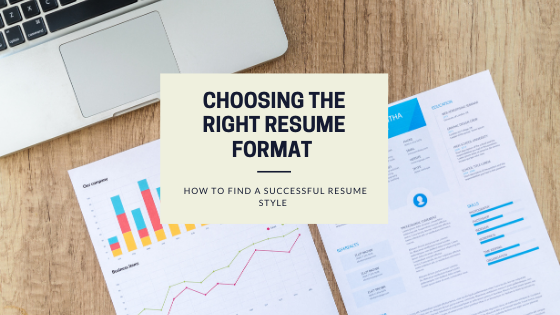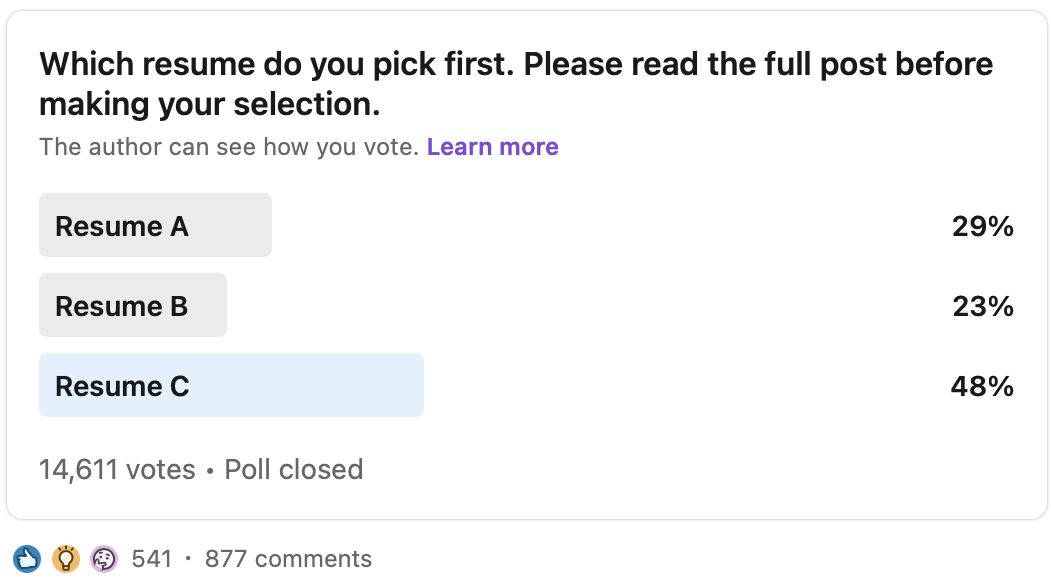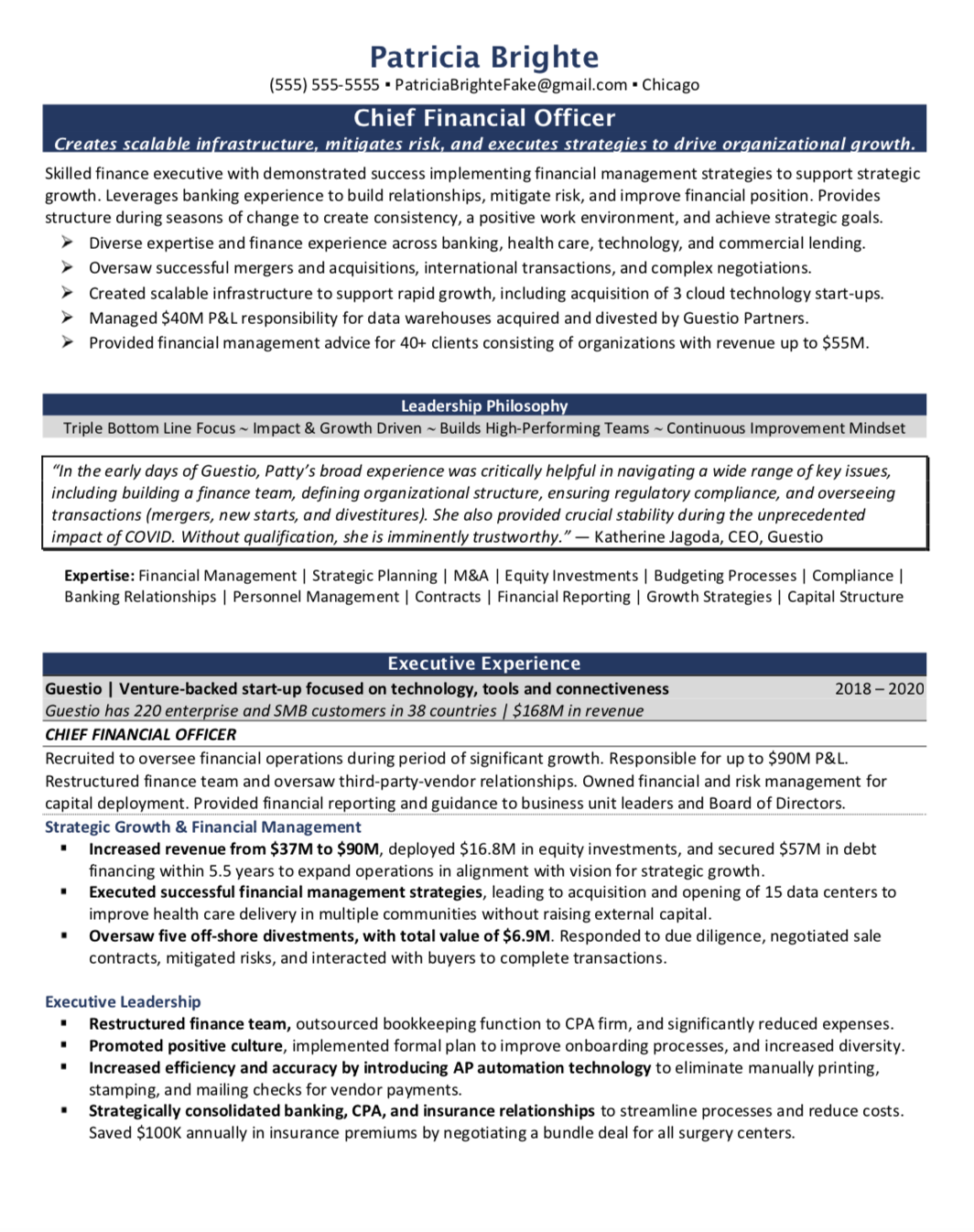
Which Resume Format is the Best: Chronological, Hybrid, Graphic or Functional?
Executive job seekers all know the importance of crafting an exceptional resume: your resume is the first impression you make, and the first step in finding your next great opportunity. And while we’re taught to not to judge things by their appearance, resumes often prove an exception to this rule. Choosing the right resume format is important in positioning yourself as the ideal candidate for that next great job.
According to the latest study by Ladders, recruiters spend just 7.4 seconds scanning a resume. Recruiters size you up in that short time, and decide whether or not to move forward with you. The study showed that recruiters spend the majority of those few seconds focusing on the top of the resume before skimming the rest.
Resume format clearly matters — perhaps just as much as content. Does your resume format present you in a way that gets you noticed and effectively tells your story?
Common Resume Formats
Chronological Resumes
Chronological resumes are one of the most common resume formats. A chronological resume focuses on your work history and lists your experience in chronological order, starting with the most recent. Each work history section focuses on the specific skills, responsibilities and accomplishments of that time period. The reverse chronological progression helps to highlight the advancements you’ve made in your career. This resume format is simple and straightforward, and easy to read. Chronological resumes are also popular because they easily pass an ATS (applicant tracking system).
Functional Resumes
A functional resume focuses on your skills and experience, rather than your work history. This format highlights your main skills, followed by a brief section (if any) on work history. Because functional resumes shift the focus away from work experience, a lot of recruiters and HR managers don’t like this format. The lack of focus on work experience can often raise concerns about what you’ve actually accomplished in your career.
“Functional resumes don’t highlight an individual’s accomplishments,” says Lee Andrese, Principal and Managing Partner at akathame. “While they’re easy to scan, the story of an individual’s career is buried between the lines. The more senior the candidate, the more important the information between the lines becomes.”
“I have a saying: “Function is fine, but a story by design is where a candidate and hiring manager align,” adds Andrese.

Graphic Resumes
A graphic resume features design and graphic elements in the resume alongside text. This format can involve layout, color, design, font styling, and formatting. Traditional resume formats use text to list work experience, skills and education, while graphic resume formats use stylistic elements to organize content. Graphic resumes are visually rich, and they’re more commonly seen in creative industries.
Executive Hybrid Resumes
An executive hybrid resume is essentially a hybrid of resume formats, combining the strongest features of the different styles. With an executive hybrid resume, you can customize your resume to create a compelling story of your career. You can highlight your skills and work history experience, and emphasize key targeted areas. The executive hybrid format provides more opportunities to tailor your resume to a job description. The executive hybrid format has subtle design elements like formatting and styling to make your resume more compelling. Executive hybrid resumes enable jobseekers to create a rich, targeted resume appealing across all industries.
Briefcase Coach recently conducted a poll on LinkedIn on resume formats, based on a scenario of reviewing resumes as the hiring manager for a director level position. Over 5,000 professionals responded, and close to half of those participating voted that they would choose an executive hybrid resume over a chronological or graphic resume.
The Briefcase Coach Resume Poll
Let’s imagine for a second that you are the hiring manager for a director level role.
The recruiter you are working with hands you a stack of 30 printed off resumes to review. You are feeling a bit overwhelmed by the number of applications.
You quickly scan the first three resumes in your stack. Based PURELY on the look/design of the resumes (not the content), if you had to pick the candidate that you think will be most impressive, which one do you choose?

You are making a choice based on your perception of their competency.
A. The resume written in Times New Roman Font with clear headers but no other design elements.
B. A resume created using design software. Has photo of candidate on the document and an infographic view of their career history.
C. A resume written in Calibri font with clear headers and some light design elements such as bolding and shading.

Strength in Simplicity in a Chronological Resume
For those that chose Resume A, a chronological resume, they described this format as simple, easy to follow, and concise. Many said that it was a serious and straightforward resume well-suited to a director-level executive role. “Being a person that DOES read hundreds (if not thousands) of resumes a week, I choose A. Crisp, clean and simple. I’m focused on CONTENT,” says recruiter Kristen Fife.
Those who use a chronological format for their own resumes pointed out the importance of the format’s ability to get past an ATS. “In a COVID hiring environment, computer based tracking, evaluation, and analytics replace the human element in over 90% of the corporate hiring spectrum,” says Barak Ness. “So a resume created solely to appease the basic analyzation systems offers the best opportunity to be recognized.”
A Graphic Resume Tells Visual Story
The graphic resume, Resume B, presented a creative visual approach, and many responders who chose this format called it a differentiator in the current job market climate. The majority of responders said the graphic resume format is best for creative or design fields. Responders described the format as eye-catching and visually appealing. Many said that a graphic resume is a good representation of your overall portfolio for a relevant industry.
“For a creative leaning job, I would pick candidate B,” says Design Lead Erin McCollum. “First impressions are a big deal, and looking at something designed while putting a face to the name creates a huge impact. You may not have as much experience as another candidate, but this format at least ensures that the hiring manger is drawn to it and spends extra time looking at it.”
An Executive Hybrid Resume Worth the Effort
The clear winner was Resume C, the executive hybrid resume. Responders preferred this resume format with its focus on content combined with its effort in presentation. The executive hybrid resume format captured responders’ attention with its shading and font style. The stylistic elements drew their eyes to key sections. Responders also liked that the executive hybrid resume format is ATS-friendly.
Responders liked the executive hybrid resume’s contemporary look. Many said it showed extra thought and attention by the executive job seeker. They appreciated that the format offered a little differentiation from the traditional chronological resume format. “Looking at it from a hirer’s perspective, A is very clear and concise, but C give more opportunity to explain context and content,” says Andy Smyth.
“Effort went into multiple aspects,” says John Porterfield. “They attempt to bring the readers attention to several key points in the resume, but do not go overboard by pulling the reader away from pertinent information. The best of both worlds.”
Example of an Executive Hybrid Resume

Diana Hobler
I’m a journalist by trade, and I’ve worked as a writer and editor covering financial services, personal finance, business and technology. My experience in finance led to a job on Wall Street, where I worked as a writer in marketing for an investment firm before I moved on to freelancing.
I’m a grammar purist with a keen eye for detail, a passion for research, and a penchant for telling descriptive stories. I love the craft of writing, and transforming ideas and quotes into a cohesive, powerful narrative.
